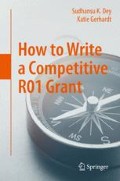Abstract
Beginnings are some of the most confused, exciting, overwhelming, daunting times you will encounter when starting your research program. But the beginning is set even further back than most realize. This process necessarily starts from an idea, the zygote of a project nestled in your brain.
Access this chapter
Tax calculation will be finalised at checkout
Purchases are for personal use only
Notes
- 1.
Capes-Davis, A., Theodosopoulos, G., Atkin, I., Drexler, H. G., Kohara, A., MacLeod, R. A.F., Masters, J. R., Nakamura, Y., Reid, Y. A., Reddel, R. R. and Freshney, R. I. Check your cultures! A list of crosscontaminated or misidentified cell lines. Int. J. Cancer, 2010; 127: 1–8. doi: 10.1002/ijc.25242
- 2.
“Implementing Rigor and Transparency in NIH and AHRQ Research Grant Application.” National Institutes of Health. Notice Number: NOT-OD-16-011. October 9, 2015.
- 3.
Lauer, Mike. “Authentication of Key Biological and/or Chemical Resources in NIH Grant Applications.” Open Mike-Extramural Research. National Institutes of Health. January 29, 2016.
Author information
Authors and Affiliations
Appendices
*Addendum: Revising an Application
Many investigators are not awarded on their first attempt, especially when the NIH budget is restricted, as in recent years. Therefore, it is necessary to understand how to respond when you are preparing a revision or resubmission.
Criticism is a necessary part of growth, but sometimes it is hard to get past the initial sting. To move forward with your grant application, you must be able to accept the criticism and respond to the comments constructively, either in refutation or agreement. Do not allow a defensive reaction to inspire an arrogant response. If you portray these negative attitudes in the revised grant, especially through a written response or on a professional letterhead, they can damage your acceptability and haunt you for years in unexpected ways.
Strive for clarity and sincerity in your responses. You will have one page to respond to the reviewer’s comments, labeled as your Introduction. However, you are still limited to 12 pages for your Specific Aims and Approach, so you cannot expand on it if you are already at the limit, only replace or revise. If you do not agree with the reviewers, be prepared to defend your work. Remember that you are the PI on this project. You have done the work to bring this application together. Proceed respectfully, with grace and honor. Delete words that reveal uncertainty from your response, such as “may,” “might,” “could,” etc. Confidence can make all the difference in how someone reads your response, and by showing your own commitment to the project, you demonstrate your strength and inspire the reviewers assigned to your study section to feel more positive toward your work.
*Addendum: Sample R01 and Letters of Support (See Below)
To serve as a sample of the tools and methods we discuss throughout this guide, we have included a successful R01 grant that was awarded after one resubmission. This particular grant scored well with the NIH when it was first reviewed. However, the budget restrictions and percentile funding prevented the grant from being funded. The investigator resubmitted the grant to address the reviewers’ points and the revision scored within the funding range. The letters of support that accompanied this grant application are also included to portray how the information and tone may vary depending on the role of the supporter.
Authentication of Research Materials
It should be noted that the NIH released their update regarding a separate Authentication document in January of 2016. As such, this grant does not include that document. It does, however, include relevant information within the approach section. Transparency goes hand in hand with clarity. With these goals in mind, an investigator can write strong grants that improve the quality of research in the long run.
Rights and permissions
Copyright information
© 2016 Springer International Publishing Switzerland
About this chapter
Cite this chapter
Dey, S.K., Gerhardt, K. (2016). Introduction: Fear of Uncertainty—Enter at Your Own Risk. In: How to Write a Competitive R01 Grant. Springer, Cham. https://doi.org/10.1007/978-3-319-41360-0_1
Download citation
DOI: https://doi.org/10.1007/978-3-319-41360-0_1
Published:
Publisher Name: Springer, Cham
Print ISBN: 978-3-319-41359-4
Online ISBN: 978-3-319-41360-0
eBook Packages: Biomedical and Life SciencesBiomedical and Life Sciences (R0)

